A few posts ago we ran a simple basic analysis looking at the relative value of oil with respect to a number of other core commodities. We revisit that post again with more recent and updated data as well as add a table that allows for a quick relative comparison of commodity prices against crude oil prices across key oil price dates.
[ad#Grey back med rectangle]
The analysis has been extended to cover the period 1st January 2008 to 21st May 2010 (except for Crude Oil for which data is available till 30th April 2010). For the analysis all commodity prices have been denominated in USD, i.e. prices for commodities such as silver and crude palm oil futures which are normally expressed in another currency (Sterling and Malaysian Ringgit respectively) have been converted to the US currency by applying the relevant exchange rate at the given dates.
In general a higher number relative to past numbers indicates that 1 barrel of crude oil can purchase more, therefore the commodity is now cheaper in relative terms to crude oil. A lower number relative to the past numbers tells us that fewer units of that commodity can be purchased for the price of the crude oil, thus meaning that that particular commodity is more expensive as compared to crude oil in relative terms.
A summary of the analysis is provided in the table below followed by a commodity wise analysis. The numbers are averages for the specified months:

Commodity wise analysis is presented below:
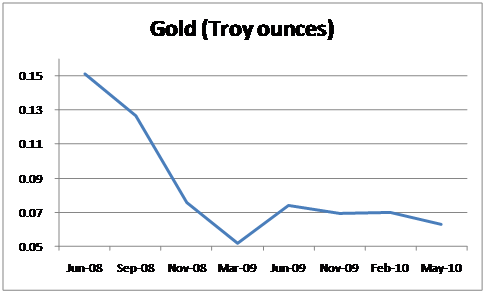
In June 2008 1 barrel of crude oil was equivalent in value to 0.15 troy ounces of gold. In March 2009 this declined to 0.05 troy ounces indicating that gold became more expensive in relative terms as compared to oil. By May 2010 it was up 0.01 troy ounces to 0.06 telling us that oil gained some of the value it had previously lost against gold. As compare to the position in Feb 2010, the value of gold has increased as crude oil as can be gauge by the declining slope of the graph indicating that fewer ounces of gold could be purchased with the value of 1 barrel of WTI.
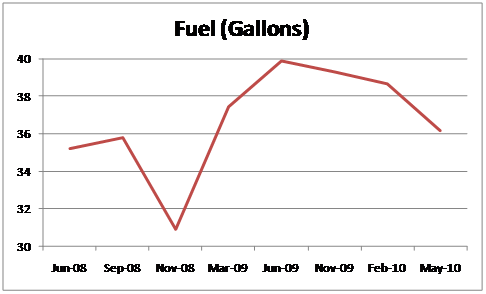
Fuel Oil has gained around 9% as compared to WTI. By May 2010 it had reached an average of around 36 barrels for every barrel of crude oil which is just one gallon more that the position it held in June 2008 making it relatively more expensive against crude oil as compared to the position in March 2009- Nov 2009.
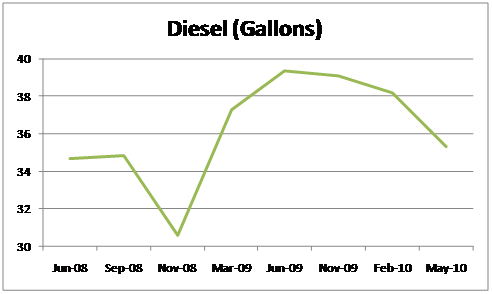
Diesel Oil shows a similar trend to that experience for Fuel Oil above with the commodity becoming more expensive relative to crude oil as of May 2010.
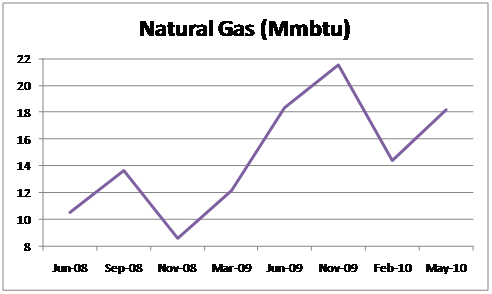
Natural Gas has become cheaper relative to crude oil in May 2010 as compared to its position in Feb 2010 as more of the commodity could be purchased on average during the month. As compared to June 2008, one barrel of crude oil could purchase 7 MMbtu more of natural gas in May 2010 going up from 10.55 MMbtu to 18.17 MMbtu.
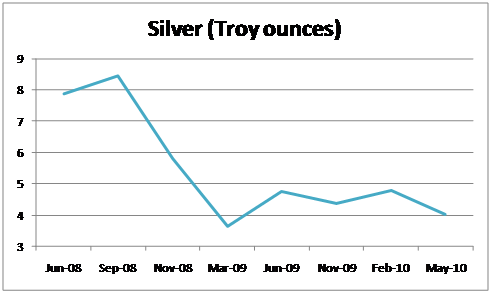
Silver has become relatively more expensive in May 2010 as compared to Nov 2009 and Feb 2010. Where 1 barrel of WTI was equivalent in value to 4.38 and 4.79 troy ounces in these two months respectively it is now only equal to 4.03 troy ounces of silver in May 2010.
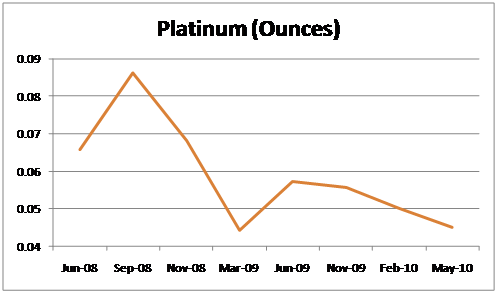
Platinum shows a similar trend to silver as it has continued to become more expensive since June 2009. As of May 2010 0.045 ounces could be purchase for the value of 1 barrel of oil.
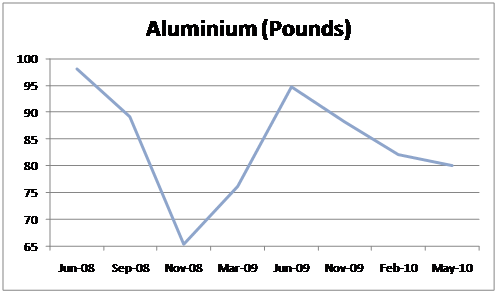
Aluminum too has continued to become more expensive with May 2010 prices indicating that 1 barrel of WTI was equal to just 80 pounds of the commodity as compared to 82 in Feb 2010.
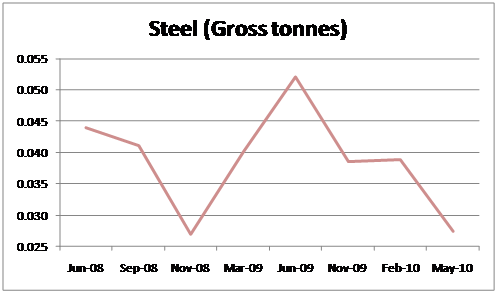
Steel has also become more expensive relative to WTI. In May 2010 the quantity that could be purchased touched levels last seen in Nov-2008 of 0.027 gross tones of steel for 1 barrel of crude oil.
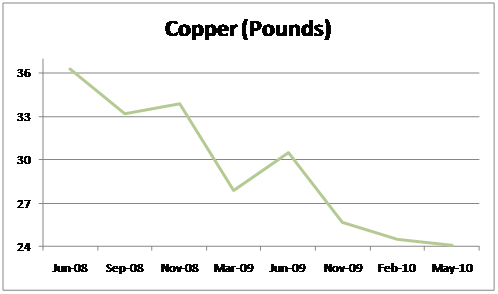
Copper has generally shown a downward trend indicating its increasing value relative to crude oil since June 2008. This trend has continued into May 2010 with the amount of units that could be purchased from 1 barrel of WTI going down 0.40 pounds since Feb 2010 to stand at an average of 24.09 pounds for 1 barrel of WTI.
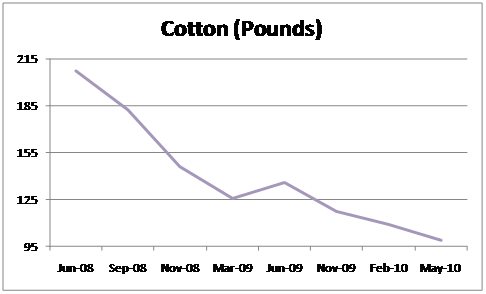
Similar to copper, cotton to has gradually continued to increase in value against crude oil. In May 2010 only 99 pounds of cotton could be purchased with 1 barrel of WTI as compared to over 206 pounds in June 2008.
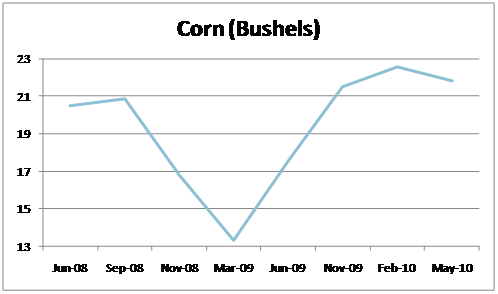
As compared to Feb 2010 corn has increased in value relative to crude oil in May 2010 where the bushels that could be exchanged for the value of 1 barrel of oil declined from 22.53 to 21.81. However it is still considerably cheaper compared to the position it held in Mar 2009 where 1 barrel of WTI had an equivalent value to 13.34 bushels of corn.
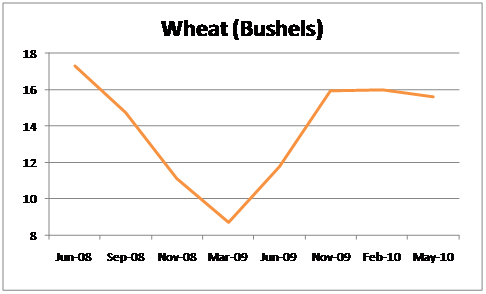
Similar in trend to corn, wheat has demonstrated a slight increase in its value relative to WTI in May 2010 as compared to Nov-09 and Feb 2010. The quantity that could be purchased from the value of 1 barrel of crude oil declined from around 16 bushels to around 15.63 bushels in May 2010.
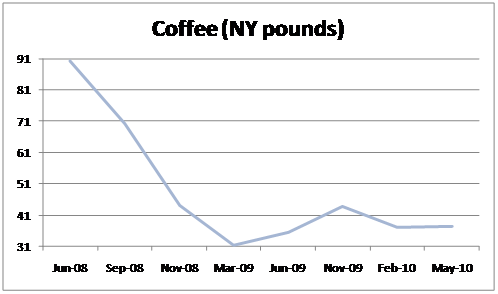
Coffee’s value in May 2010 remained almost constant as compared to Feb 2010 value relative to WTI, only becoming fractionally cheaper. However as compared to June 2008 numbers coffee still remains relatively more expensive in May 2010.
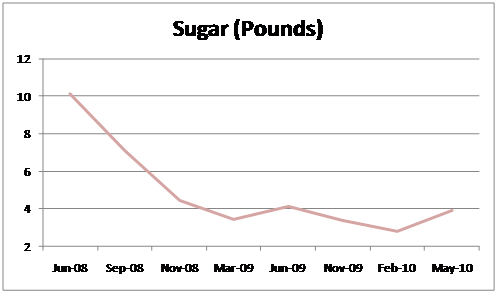
Since Feb 2010, sugar has gotten less expensive. 1 barrel of crude oil can now purchase 3.9 pounds of sugar in May 2010 as compared to only 2.8 pounds in Feb 2010. Historically, looking at June 2008, it still is considerably more expensive.
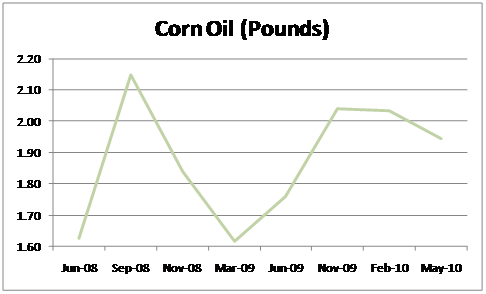
Corn Oil increased in value against crude oil with the quantity that could be purchased in May 2010 declining by 4% since Feb 2010 to stand at 1.95 pounds.
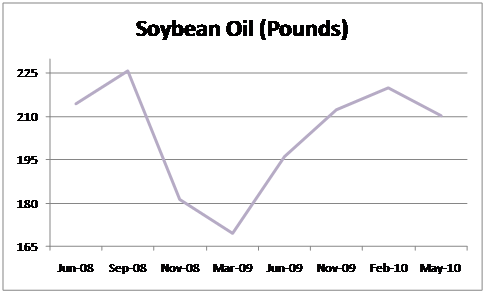
Soybean Oil too witnessed an increase in its value as compared to February 2010 with the quantity of the commodity going down from 220 pounds in Feb 2010 to 210 pounds in May 2010.
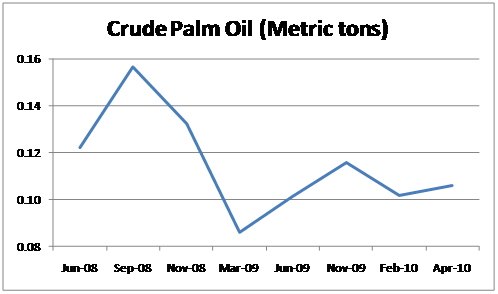
As mentioned earlier data for Crude Palm Oil futures was only available till 30 April 2010. As compared to February 2010 figures we see that Crude Palm Oil has become cheaper in relative terms as compared to WTI as the quantity that could be bought for the value of one barrel of crude oil went up from 0.10 metric tons to 0.11 metric tons.
[ad#Grey back med rectangle]